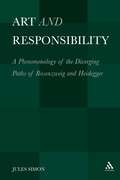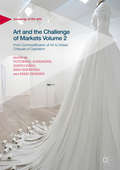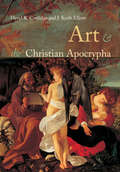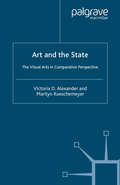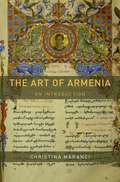- Table View
- List View
Art and Reform in the Late Renaissance: After Trent (Visual Culture in Early Modernity)
by Jesse M. LockerDrawing on recent research by established and emerging scholars of sixteenth- and seventeenth-century art, this volume reconsiders the art and architecture produced after 1563 across the conventional geographic borders. Rather than considering this period a degraded afterword to Renaissance classicism or an inchoate proto-Baroque, the book seeks to understand the art on its own terms. By considering artists such as Federico Barocci and Stefano Maderno in Italy, Hendrick Goltzius in the Netherlands, Antoine Caron in France, Francisco Ribalta in Spain, and Bartolomeo Bitti in Peru, the contributors highlight lesser known "reforms" of art from outside the conventional centers. As the first text to cover this formative period from an international perspective, this volume casts new light on the aftermath of the Renaissance and the beginnings of "Baroque."
Art and Reform in the Late Renaissance: After Trent (Visual Culture in Early Modernity)
by Jesse M. LockerDrawing on recent research by established and emerging scholars of sixteenth- and seventeenth-century art, this volume reconsiders the art and architecture produced after 1563 across the conventional geographic borders. Rather than considering this period a degraded afterword to Renaissance classicism or an inchoate proto-Baroque, the book seeks to understand the art on its own terms. By considering artists such as Federico Barocci and Stefano Maderno in Italy, Hendrick Goltzius in the Netherlands, Antoine Caron in France, Francisco Ribalta in Spain, and Bartolomeo Bitti in Peru, the contributors highlight lesser known "reforms" of art from outside the conventional centers. As the first text to cover this formative period from an international perspective, this volume casts new light on the aftermath of the Renaissance and the beginnings of "Baroque."
Art and Religion in Africa
by Rosalind HackettAfrica's religious and artistic traditions constitute a primary example of its intellectual and cultural vitality. Artistic works play a vital role - especially where oral traditions dominate - in communicating ideas about the relationship between the human, spiritual and natural worlds. This work is a comparative study of Africa's visual and performing arts, concentrating on their geographical, material and gendered diversity, and focusing on the relation of these arts to African religion. The author combines ethnographic and art-historical methodology but does not assume any prior knowledge of African art or African religion. The text seeks a greater understanding of the philosophical and religious aspects of African art, thus challenging western perceptions of what is "important" in terms of artistic representation. This approach reveals the transformative capacities and multi-dimensionality of African art. The work also highlights the changes brought about by Christianity, Islam and the newer religious movements in post-colonial Africa.
Art and Responsibility: A Phenomenology of the Diverging Paths of Rosenzweig and Heidegger
by Jules SimonTwo German philosophers working during the Weimar Republic in Germany, between the two World Wars, produced seminal texts that continue to resonate almost a hundred years later. Franz Rosenzweig-a Jewish philosopher, and Martin Heidegger-a philosopher who at one time was studying to become a Catholic priest, each in their own, particular way include in their writings powerful philosophies of art that, if approached phenomenologically and ethically, provide keys to understanding their radically divergent trajectories, both biographically and for their philosophical heritage. Simon provides a close reading of some of their essential texts-The Star of Redemption for Rosenzweig and Being and Time and The Origin of the Work of Art for Heidegger-in order to draw attention to how their philosophies of art can be understood to provide significant ethical directives.
Art and the Challenge of Markets Volume 2: From Commodification of Art to Artistic Critiques of Capitalism (Sociology of the Arts)
by Victoria D. Alexander Samuli Hägg Simo Häyrynen Erkki SevänenArt and the Challenge of Markets Volumes 1 & 2 examine the politics of art and culture in light of the profound changes that have taken place in the world order since the 1980s and 1990s. The contributors explore how in these two decades, the neoliberal or market-based model of capitalism started to spread from the economic realm to other areas of society. As a result, many aspects of contemporary Western societies increasingly function in the same way as the private enterprise sector under traditional market capitalism.This second volume analyses the relationships of art with contemporary capitalist economies and instrumentalist cultural policies, and examines several varieties of capitalist-critical and alternative art forms that exist in today’s art worlds. It also addresses the vexed issues of art controversies and censorship. The chapters cover issues such as the culturalization of the economy, aesthetics and anti-aesthetics, the societal benefits of works of art, art's responsibility to society, "artivism", activist arts as protest and capitalism-critical works, and controversies over nudity in art, as well as considering the marketisation of emerging visual arts worlds in East Asia. The book ends with the a concluding chapter suggesting that even in today's marketized and commercialized environments, art will find a way. Both volumes provide students and scholars across a range of disciplines with an incisive, comparative overview of the politics of art and culture and national, international and transnational art worlds in contemporary capitalism.
Art and the Christian Apocrypha
by David R. Cartlidge J. Keith ElliotThe Christian canon of scripture, known as the New Testament, excluded many of the Church's traditional stories about its origins. Although not in the Bible, these popular stories have had a powerful influence on the Church's traditions and theology, and a particularly marked effect on visual representations of Christian belief. This book provides a lucid introduction to the relationship between the apocryphal texts and the paintings, mosaics, and sculpture in which they are frequently paralleled, and which have been so significant in transmitting these non-Biblical stories to generations of churchgoers.
Art and the Christian Apocrypha
by David R. Cartlidge J. Keith ElliotThe Christian canon of scripture, known as the New Testament, excluded many of the Church's traditional stories about its origins. Although not in the Bible, these popular stories have had a powerful influence on the Church's traditions and theology, and a particularly marked effect on visual representations of Christian belief. This book provides a lucid introduction to the relationship between the apocryphal texts and the paintings, mosaics, and sculpture in which they are frequently paralleled, and which have been so significant in transmitting these non-Biblical stories to generations of churchgoers.
Art and the Church: Ecclesiastical Encounters with Contemporary Art
by Jonathan Koestle-CateA vibrant critical exchange between contemporary art and Christianity is being increasingly prompted by an expanding programme of art installations and commissions for ecclesiastical spaces. Rather than 'religious art' reflecting Christian ideology, current practices frequently initiate projects that question the values and traditions of the host space, or present objects and events that challenge its visual conventions. In the light of these developments, this book asks what conditions are favourable to enhancing and expanding the possibilities of church-based art, and how can these conditions be addressed? What viable language or strategies can be formulated to understand and analyse art's role within the church? Focusing on concepts drawn from anthropology, comparative religion, art theory, theology and philosophy, this book formulates a lexicon of terms built around the notion of encounter in order to review the effective uses and experience of contemporary art in churches. The author concludes with the prognosis that art for the church has reached a critical and decisive phase in its history, testing the assumption that contemporary art should be a taken-for-granted element of modern church life. Art and the Church: A Fractious Embrace uniquely combines conceptual analysis, critical case studies and practical application in a rigorous and inventive manner, dealing specifically with contemporary art of the past twenty-five years, and the most recent developments in the church's policies for the arts.
Art and the Church: Ecclesiastical Encounters with Contemporary Art
by Jonathan Koestle-CateA vibrant critical exchange between contemporary art and Christianity is being increasingly prompted by an expanding programme of art installations and commissions for ecclesiastical spaces. Rather than 'religious art' reflecting Christian ideology, current practices frequently initiate projects that question the values and traditions of the host space, or present objects and events that challenge its visual conventions. In the light of these developments, this book asks what conditions are favourable to enhancing and expanding the possibilities of church-based art, and how can these conditions be addressed? What viable language or strategies can be formulated to understand and analyse art's role within the church? Focusing on concepts drawn from anthropology, comparative religion, art theory, theology and philosophy, this book formulates a lexicon of terms built around the notion of encounter in order to review the effective uses and experience of contemporary art in churches. The author concludes with the prognosis that art for the church has reached a critical and decisive phase in its history, testing the assumption that contemporary art should be a taken-for-granted element of modern church life. Art and the Church: A Fractious Embrace uniquely combines conceptual analysis, critical case studies and practical application in a rigorous and inventive manner, dealing specifically with contemporary art of the past twenty-five years, and the most recent developments in the church's policies for the arts.
Art and the State: The Visual Arts in Comparative Perspective (St Antony's Series)
by V. Alexander M. RueschemeyerThis book examines the impact of states and their policies on visual art. States shape the role of art and artists in society, influence the development of audiences, support artistic work, and even affect the very nature of artistic production. The book contrasts developments in the United States with art policies in Britain and in the social democratic states of Norway and Sweden. In addition, it analyzes revealing transitions - the changes brought about in East Germany after unification and the experiences of artists who left the Soviet Union for the west. The result is a significant contribution to the sociology and the political economy of art.
Art as Biblical Commentary: Visual Criticism from Hagar the Wife of Abraham to Mary the Mother of Jesus (The Library of Hebrew Bible/Old Testament Studies)
by J. Cheryl ExumArt as Biblical Commentary is not just about biblical art but, more importantly, about biblical exegesis and the contributions visual criticism as an exegetical tool can make to biblical exegesis and commentary. Using a range of texts and numerous images, J. Cheryl Exum asks what works of art can teach us about the biblical text. 'Visual criticism' is her term for an approach that addresses this question by focusing on the narrativity of images-reading them as if, like texts, they have a story to tell-and asking what light an image's 'story' can shed on the biblical narrator's story. In Part I, Exum elaborates on her approach and offers a personal testimony to the value of visual criticism. Part 2 examines in detail the story of Hagar in Genesis 16 and 21. Part 3 contains chapters on erotic looking and voyeuristic gazing in the stories of Bathsheba, Susanna, Joseph and Potiphar's wife and the Song of Songs; on the distribution of renown among Jael, Deborah and Barak; on the Bible's notorious women, Eve and Delilah; and on the sacrificed female body in the stories of the Levite's wife (Judges 19) and Mary the mother of Jesus.
Art as Biblical Commentary: Visual Criticism from Hagar the Wife of Abraham to Mary the Mother of Jesus (The Library of Hebrew Bible/Old Testament Studies)
by J. Cheryl ExumArt as Biblical Commentary is not just about biblical art but, more importantly, about biblical exegesis and the contributions visual criticism as an exegetical tool can make to biblical exegesis and commentary. Using a range of texts and numerous images, J. Cheryl Exum asks what works of art can teach us about the biblical text. 'Visual criticism' is her term for an approach that addresses this question by focusing on the narrativity of images-reading them as if, like texts, they have a story to tell-and asking what light an image's 'story' can shed on the biblical narrator's story. In Part I, Exum elaborates on her approach and offers a personal testimony to the value of visual criticism. Part 2 examines in detail the story of Hagar in Genesis 16 and 21. Part 3 contains chapters on erotic looking and voyeuristic gazing in the stories of Bathsheba, Susanna, Joseph and Potiphar's wife and the Song of Songs; on the distribution of renown among Jael, Deborah and Barak; on the Bible's notorious women, Eve and Delilah; and on the sacrificed female body in the stories of the Levite's wife (Judges 19) and Mary the mother of Jesus.
Art as Theology: From the Postmodern to the Medieval
by Andreas AndreapoulosReligion and spirituality are key aspects of the contemporary art scene. Following Ronald Barthes' 'death of the author' - which argued for the dissociation of work from creator - works of art have withdrawn as independent objects, giving way to a growing religious awareness or practice. 'Art and Theology' examines the connection between art and religion in ancient Jewish drama, Greek tragedy, the Renaissance, the Byzantine icon and the medieval cathedral. The book explores how art lost its sacred character in the late Middle Ages and how the current withdrawal or 'death' of art and the fusion of the limits of art and life are consistent with the medieval view of the religious icon.
Art as Theology: From the Postmodern to the Medieval
by Andreas AndreapoulosReligion and spirituality are key aspects of the contemporary art scene. Following Ronald Barthes' 'death of the author' - which argued for the dissociation of work from creator - works of art have withdrawn as independent objects, giving way to a growing religious awareness or practice. 'Art and Theology' examines the connection between art and religion in ancient Jewish drama, Greek tragedy, the Renaissance, the Byzantine icon and the medieval cathedral. The book explores how art lost its sacred character in the late Middle Ages and how the current withdrawal or 'death' of art and the fusion of the limits of art and life are consistent with the medieval view of the religious icon.
Art Cinema and Theology: The Word Was Made Film (PDF)
by Justin PonderThis book examines postmodern theology and how it relates to the cinematic style of Robert Bresson, Carl Theodor Dreyer, Ingmar Bergman, and Luis Buñuel. Ponder demonstrates how these filmmakers forefront religious issues in their use of mise en scène. He investigates both the technical qualities of film “flesh” and its theological features. The chapters show how art cinema uses sound, editing, lighting, and close-ups in ways that critique doctrine’s authoritarianism, as well as philosophy’s individualism, to suggest postmodern theologies that emphasize community. Through this book we learn how the cinematic style of modernist auteurs relates to postmodern theology and how the industry of art cinema constructs certain kinds of film-watching subjectivity.
Art Crime: Terrorists, Tomb Raiders, Forgers and Thieves (Non-ser.)
by Noah CharneySince the Second World War, art crime has shifted from a relatively innocuous, often ideological crime, into a major international problem, considered by some to be the third-highest grossing criminal trade worldwide. This rich volume features essays on art crime by the most respected and knowledgeable experts in this interdisciplinary subject.
Art, Desire, and God: Phenomenological Perspectives (Expanding Philosophy of Religion)
by Kevin G. Grove, Christopher C. Rios, and Taylor J. NutterBringing together thinkers from philosophy of religion, religious studies, music, art, and film, while drawing on a wealth of phenomenological resources and methods, a team of renowned scholars provide new vantages on the question of how art is an expression of the human desire for God. In three interrelated parts, chapters employ phenomenological tools to propose new ways for speaking of the desire for God. Scholars first draw upon music, sculpture, film, and painting to develop ways of expressing diverse philosophical and religious aspects characteristic of aesthetic experience. The discussion then opens up to examine the mystical and wounded aspects of embodied interface with God. The final part investigates embodied aesthetic praxis in philosophy of religion and religious studies. With several contributions engaging with the embodied, aesthetic experience of underrepresented voices, Art, Desire, and God offers constructive phenomenological bridges across divides of disciplines, aesthetic experiences, and embodied actions.
Art, Desire, and God: Phenomenological Perspectives (Expanding Philosophy of Religion)
Bringing together thinkers from philosophy of religion, religious studies, music, art, and film, while drawing on a wealth of phenomenological resources and methods, a team of renowned scholars provide new vantages on the question of how art is an expression of the human desire for God. In three interrelated parts, chapters employ phenomenological tools to propose new ways for speaking of the desire for God. Scholars first draw upon music, sculpture, film, and painting to develop ways of expressing diverse philosophical and religious aspects characteristic of aesthetic experience. The discussion then opens up to examine the mystical and wounded aspects of embodied interface with God. The final part investigates embodied aesthetic praxis in philosophy of religion and religious studies. With several contributions engaging with the embodied, aesthetic experience of underrepresented voices, Art, Desire, and God offers constructive phenomenological bridges across divides of disciplines, aesthetic experiences, and embodied actions.
Art, Imagination and Christian Hope: Patterns of Promise (Routledge Studies in Theology, Imagination and the Arts)
by Gavin HoppsIn hope, Christian faith reconfigures the shape of what is familiar in order to pattern the contours of God's promised future. In this process, the present is continuously re-shaped by ventures of hopeful and expectant living. In art, this same poetic interplay between past, present and future takes specific concrete forms, furnishing vital resources for sustaining an imaginative ecology of hope. This volume attends to the contributions that architecture, drama, literature, music and painting can make, as artists trace patterns of promise, resisting the finality of modernity's despairing visions and generating hopeful living in a present which, although marked by sin and death, is grasped imaginatively as already pregnant with future.
Art, Imagination and Christian Hope: Patterns of Promise (Routledge Studies in Theology, Imagination and the Arts)
by Gavin HoppsIn hope, Christian faith reconfigures the shape of what is familiar in order to pattern the contours of God's promised future. In this process, the present is continuously re-shaped by ventures of hopeful and expectant living. In art, this same poetic interplay between past, present and future takes specific concrete forms, furnishing vital resources for sustaining an imaginative ecology of hope. This volume attends to the contributions that architecture, drama, literature, music and painting can make, as artists trace patterns of promise, resisting the finality of modernity's despairing visions and generating hopeful living in a present which, although marked by sin and death, is grasped imaginatively as already pregnant with future.
Art, Literature and Religion in Early Modern Sussex: Culture and Conflict
by Andrew HadfieldArt, Literature and Religion in Early Modern Sussex is an interdisciplinary study of a county at the forefront of religious, political and artistic developments in early-modern England. Ranging from the schism of Reformation to the outbreak of Civil War, the volume brings together scholars from the fields of art history, religious and intellectual history and English literature to offer new perspectives on early-modern Sussex. Essays discuss a wide variety of topics: the coherence of a county divided between East and West and Catholic and Protestant; the art and literary collections of Chichester cathedral; communities of Catholic gentry; Protestant martyrdom; aristocratic education; writing, preaching and exile; local funerary monuments; and the progresses of Elizabeth I. Contributors include Michael Questier; Nigel Llewellyn; Caroline Adams; Karen Coke; and Andrew Foster. The collection concludes with an Afterword by Duncan Salkeld (University of Chichester). This volume extends work done in the 1960s and 70s on early-modern Sussex, drawing on new work on county and religious identities, and setting it into a broad national context. The result is a book that not only tells us much about Sussex, but which also has a great deal to offer all scholars working in the field of local and regional history, and religious change in England as a whole.
Art, Literature and Religion in Early Modern Sussex: Culture and Conflict
by Andrew HadfieldArt, Literature and Religion in Early Modern Sussex is an interdisciplinary study of a county at the forefront of religious, political and artistic developments in early-modern England. Ranging from the schism of Reformation to the outbreak of Civil War, the volume brings together scholars from the fields of art history, religious and intellectual history and English literature to offer new perspectives on early-modern Sussex. Essays discuss a wide variety of topics: the coherence of a county divided between East and West and Catholic and Protestant; the art and literary collections of Chichester cathedral; communities of Catholic gentry; Protestant martyrdom; aristocratic education; writing, preaching and exile; local funerary monuments; and the progresses of Elizabeth I. Contributors include Michael Questier; Nigel Llewellyn; Caroline Adams; Karen Coke; and Andrew Foster. The collection concludes with an Afterword by Duncan Salkeld (University of Chichester). This volume extends work done in the 1960s and 70s on early-modern Sussex, drawing on new work on county and religious identities, and setting it into a broad national context. The result is a book that not only tells us much about Sussex, but which also has a great deal to offer all scholars working in the field of local and regional history, and religious change in England as a whole.
The Art Museum Redefined: Power, Opportunity, and Community Engagement (Sociology of the Arts)
by Johanna K. TaylorThis book presents a critical analysis of the power and opportunity created in the implementation of community engaged practices within art museums, by looking at the networks connecting art museums to community organizations, artists and residents. The Art Museum Redefined places the interaction of art museums and urban neighbourhoods as the central focus of the study, to investigate how museums and artists collaborate with residents and local community groups. Rather than defining the community solely from the perspective of a museum looking out at its audience, the research examines the larger networks of art organizing and creative activism connected to the museum that are active across the neighbourhood. Taylor's research encompasses the grassroots efforts of local groups and their collaboration with museums and other art institutions that are extending their reach outside their physical walls and into the community. This focus on social engagement speaks to recent emphasis in cultural policy on cultural equity and inclusion, creative place-making and community engagement at neighbourhood and city-levels, and will be of interest to students, scholars and policy-makers alike.
Art, Myth, And Ritual In Classical Greece
by Judith M. BarringerWhat do Greek myths mean and how was meaning created for the ancient viewer? In Art, Myth, and Ritual in Classical Greece, Judith Barringer considers the use of myth on monuments at several key sites - Olympia, Athens, Delphi, and Trysa - showing that myth was neither randomly selected nor purely decorative.
The Art of Armenia: An Introduction
by Christina MaranciThough immediately recognizable in public discourse as a modern state in a political "hot zone," Armenia has a material history and visual culture that reaches back to the Paleolithic era. This book presents a timely and much-needed survey of the arts of Armenia from antiquity to the early eighteenth century C.E. Divided chronologically, it brings into discussion a wide range of media, including architecture, stone sculpture, works in metal, wood, and cloth, manuscript illumination, and ceramic arts. Critically, The Art of Armenia presents this material within historical and archaeological contexts, incorporating the results of specialist literature in various languages. It also positions Armenian art within a range of broader comparative contexts including, but not limited to, the ancient Mediterranean and Near East, Byzantium, the Islamic world, Yuan-dynasty China, and seventeenth-century Europe. The Art of Armenia offers students, scholars, and heritage readers of the Armenian community something long desired but never before available: a complete and authoritative introduction to three thousand years of Armenian art, archaeology, architecture, and design.


